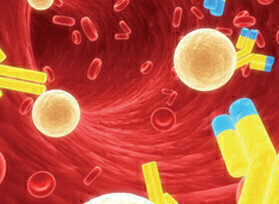News & Views
MRSA - Weak Point - Visualised by Scientists
Mar 04 2009
An enzyme that lives in MRSA and helps the dangerous bacterium to grow and spread infection through the human body has been visualised for the first time, according to a study in proceedings of the National Academy of Sciences (PNAS). Now, armed with detailed information about the structure of this enzyme, researchers hope to design new drugs that will seek it out and disable it, providing a new way of combating MRSA and other bacterial infections.
The enzyme, a ’worker-protein’ called LtaS, produces an important component of the protective outer-layer that surrounds all Staphylococcus aureus cells as well as many other bacteria that cause disease. Staphylococcus aureus is a type of bacterium that causes a variety of infections in the human body, including skin infections and abscesses, sometimes leading to blood poisoning and life-threatening lung or brain infections.
MRSA is a particular strain of Staphylococcus aureus, which has evolved to be resistant to the antibiotic methicillin and a large number of other antibiotics, and can be life threatening. To counter this drug resistance and ensure that it is possible to treat MRSA infection in the future, new antibiotics are needed that work differently, for example by attacking parts of the pathogen that are not targeted by current drugs. The team from Imperial College London behind this study, funded by the Medical Research Council, thinks that LtaS might be a good candidate target for a new antibiotic to which MRSA will not be resistant. This is because its job is to build a polymer called lipoteichoic acid (LTA), which is an important structure found on the surface of Staphylococcus aureus cells.
Although the role of the cell surface polymer LTA is not fully understood, lab tests carried out by the same researchers have shown that if the LtaS enzyme is depleted, production of LTA on the cell surface draws to a halt. As a result growth of the Staphylococcus aureus cell is blocked. So in a patient infected with MRSA, inhibiting this enzyme could clear up the infection because the bacterial cells would be unable to grow properly. Many existing antibiotics work in a similar way by inhibiting the production of other such important structures on the surface of bacterial cells. The trick, according to one of the paper’s lead authors, Dr Angelika Grundling from Imperial College London’s Division of Investigative Science, is to now find a way of using the new knowledge to develop a drug for use in real world scenarios: "We’re not quite sure how it works, but we know that this surface structure called LTA is involved in cell growth and cell division - we have shown that without it the cell cannot grow properly, and eventually dies. Because LtaS is the ’machine’, which builds LTA, developing a drug that knocks out the machine will provide us with a new way to disable the growth of these cells, which would represent a novel new treatment for MRSA and other Staphylococcus aureus infections."
Dr Grundling and her colleagues have produced a detailed image of the molecular structure of the LtaS enzyme using X-ray crystallography techniques. The image includes a map of LtaS’s
active binding site: the part of the enzyme which plays a key role in building LTA. This is the very part that researchers now need to home in on with a drug, in order to prevent the LtaS enzyme
from doing its job.
Professor Paul Freemont from Imperial’s Division of Molecular Biosciences, co-lead-author of the paper, explains the importance of the information they have gained about this particular part of
the enzyme:
"If we’re to develop a drug which disables LtaS from doing its job, then we need to make sure the drug molecule is as perfectly matched as possible to the enzyme’s binding site, so it can trick
the enzyme into taking it up. Once the drug is bound to the enzyme it will be able start its job of sabotage. "So the more detailed information about the binding site we have, the better we’ll be able to develop an effective drug to match it," he said. The two Imperial teams led by Professor Freemont and Dr Grundling now hope to work with the College’s Drug Discovery Centre to search for a biological agent that interacts with the LtaS binding site, as the basis for a new antibiotic drug. They hope that in the future such a drug could be used to treat not just MRSA, but a whole host of infections caused by bacterial pathogens. Additional funding for the research was obtained through the US National Institute of Health.
Digital Edition
ILM 49.5 July
July 2024
Chromatography Articles - Understanding PFAS: Analysis and Implications Mass Spectrometry & Spectroscopy Articles - MS detection of Alzheimer’s blood-based biomarkers LIMS - Essent...
View all digital editions
Events
Jul 28 2024 San Diego, CA USA
Jul 30 2024 Jakarta, Indonesia
Jul 31 2024 Chengdu, China
ACS National Meeting - Fall 2024
Aug 18 2024 Denver, CO, USA
Aug 25 2024 Copenhagen, Denmark


.jpg)

24_06.jpg)













